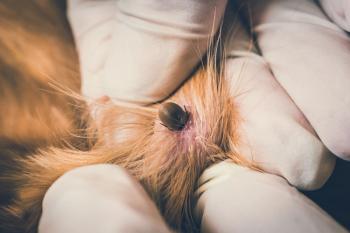
What you should know about periodontal disease
From 25-50 percent attachment loss is seen radiographically with Stage III periodontal disease.
The health of the periodontium ("peri-": around, "-odont": tooth) is vital to the health of the tooth. The structures that "surround the tooth" making up the periodontium are the attached gingiva, alveolar bone, periodontal ligament (PDL) and cementum.
Periodontal disease is a multifactorial infection complex that may be predisposed by breed, age, genetics, skull type, species, plaque, calculus, biofilm, chewing and grooming habits, other diseases, and the ability of the owner to provide home care. Periodontal disease is the progressive loss of attachment and is made up of four stages. It is a cyclic process going from active to dormant, based on treatment, then back again. Periodontitis is the active state of periodontal disease.
Studies have shown that periodontal disease is the most common disease found in adult dogs and cats.
Studies have shown that periodontal disease is the most common disease found in adult dogs and cats. Another study showed that 80 percent of dogs and 70 percent between the ages of 20-27 months exhibited clinical signs of periodontal disease. Linda DeBowes, DVM, Dipl. ACVIM, Dipl. AVDC showed, in a post-mortem study of dogs with advanced periodontal disease, bacteria from the oral cavity were found in the myocardium, kidney glomeruli and liver. A human study showed that pregnant women with periodontal disease gave birth to babies with low birth weight.
Common clinical signs associated with periodontal disease include: halitosis, bleeding gums, gingivitis (inflammation of the gums), root exposure, gingival recession, chronic sneezing (especially in Dachshunds), purulent exudate, bone loss, tooth extrusion and/or tooth mobility; leading to eventual tooth loss.
•Stages of periodontal disease
Plaque is a matrix of bacteria, salivary glycoproteins and extracellular polysaccharides that adhere to structures within the oral cavity, especially the tooth's surface. It is not a residue of food; it is that rough coating you feel on your teeth in the morning before you brush. The bacteria contained within supragingival plaque are primarily composed of gram-positive, non-motile, aerobic cocci and begin to form on the pellicle within hours of a dental cleaning.
dental facts
The bacterial make-up of subgingival plaque is comprised of gram-negative, anaerobic, motile rods. While the numbers of gram-positive, aerobic bacteria do not diminish as the periodontitis progresses, the percentage of gram-negative anaerobic bacteria becomes significantly greater. There have been more than 700 anaerobes isolated from subgingival plaque in the dog.
Stage I periodontal disease is gingivitis with no attachment loss. The gingiva will become a darker shade of pink to red extending apically (in the direction of the root) from the gingival margin. The "knife-edged" appearance of healthy gingiva will be lost due to the edematous inflammation, which can create a "pseudopocket." The amount of calculus does not indicate the degree of gingivitis.
•Destruction of bone
With Stage II periodontal disease, actual destruction of alveolar bone can be seen with intraoral radiographs. Intraoral radiographs and probing will show up to a 25-percent loss of attachment. Radiographic bone loss (horizontal) can be seen first with the loss of the crestal bone, which is the most coronal extent of the alveolar bone.
From 25-50 percent attachment loss is seen radiographically with Stage III periodontal disease. At this time, probing depths can increase due to vertical bone loss creating infrabony pockets.
Attachment loss of greater than 50 percent is found with Stage IV periodontal disease. Some degree of tooth mobility is usually present, especially in single-rooted teeth.
•Treatment
To adequately and appropriately treat and diagnose periodontal disease, the patient
must
be intubated and under general anesthesia.
Stages I and II are reversible with proper treatment, which includes removal of supra- and subgingival calculus, polishing, periodontal probing and charting, intraoral radiographs (to evaluate amount of bone loss, resorptive lesions, carious lesions, tooth vitality, endodontic disease), fluoride treatment (to strengthen enamel, desensitize any exposed dentinal tubules, provide some temporary bacterial resistance) and OraVet™ (Merial). Antibiotics will not cure periodontal disease. They, if indicated by preoperative bloodwork or pre-existing health condition, may be used; however they should never be used as a stand-alone treatment. A patient should be re-evaluated in nine to 12 months.
Stages III and IV hold a guarded to grave prognosis for the tooth based on the degree of attachment loss, owner's willingness and ability to provide home care, and the veterinarian's knowledge and capability of providing dental diagnostics and treatment options. Additional steps beyond the care mentioned for stages I and II include, as indicated:
- Gingivoplasty to reduce "pseudo-pocket" depth, usually secondary to gingival hyperplasia;
- Reverse bevel incision to remove diseased gingival margin (more advanced procedures, wet lab training recommended);
- Subgingival curettage to remove diseased tissue, microflora and debris from the gingival sulcus using a sharp curette;
- Closed root planing (periodontal pockets <5mm) using a sharp curette to remove subgingival plaque and calculus and create a smooth root surface, then placement of a perioceutic gel;
- Open root planing (periodontal pockets >5mm), requires flap surgery;
- Guided tissue regeneration using an osseoconductive product;
- Exodontia.
These patients should be re-evaluated every two to four months based on the extent of the periodontal disease, response to treatment, and the ability to provide home care.
If periodontal disease goes untreated and is allowed to progress, the patient will be fighting this infection/disease process constantly, and the tooth/teeth will be lost due to the advancing loss of the periodontium.
Knowledge of the oral structure and its anatomy, combined with proper dental equipment and instrumentation, good lighting, magnification, and a willing owner and amenable patient are vital to the treatment and prevention of periodontal disease. Essential equipment used for the diagnosis and treatment of periodontal disease are a periodontal probe/explorer, appropriate dental chart, intraoral radiography capabilities, ultrasonic or sonic scaler, a sharp curette and a dental unit with an air/water syringe.
Brushing the teeth is still the "gold standard" for plaque removal and prevention, or delaying the onset of periodontal disease. Studies have shown brushing must be done a minimum of three to four times per week to provide a noticeable benefit. Clients must be taught how to desensitize their pet to having its muzzle and oral cavity manipulated before any type of brushing can be implemented.
Positive reinforcement and "baby steps" are a must for successful home dental care. My steps include petting the muzzle, lifting the lips to see all of the teeth, opening the mouth to see the tongue and the pharyngeal area, brushing the teeth with a plain finger, brushing with a finger and animal toothpaste (there will be licking and swallowing due to the paste), brushing with animal toothpaste and appropriate sized soft-bristled tooth brushes or fingertip tooth brushes.
Note: Each of these steps might take days, weeks or months depending on the patient. Bristles are very important to reach into the gingival sulcus, which is the primary place for plaque and calculus build-up that is the beginning of gingivitis, Stage I periodontal disease. It is not recommended that clients try to brush calculus off because it will not work. Brushing harder will cause pain and might damage the gingival tissues.
Products that successfully meet pre-set criteria for effectiveness in controlling plaque and/or calculus deposition in dogs and cats can be found on the Veterinary Oral Health Council's Web site (
If these articles have sparked an interest in veterinary dentistry, I encourage you to become a member of the American Veterinary Dental Society (
Dr. Hall is with Greater Cincinnati Animal Dental Care in Wilder, Ky. He is a fellow in the Academy of Veterinary Dentistry and a 1993 veterinary graduate of The Ohio State University.
Newsletter
From exam room tips to practice management insights, get trusted veterinary news delivered straight to your inbox—subscribe to dvm360.




